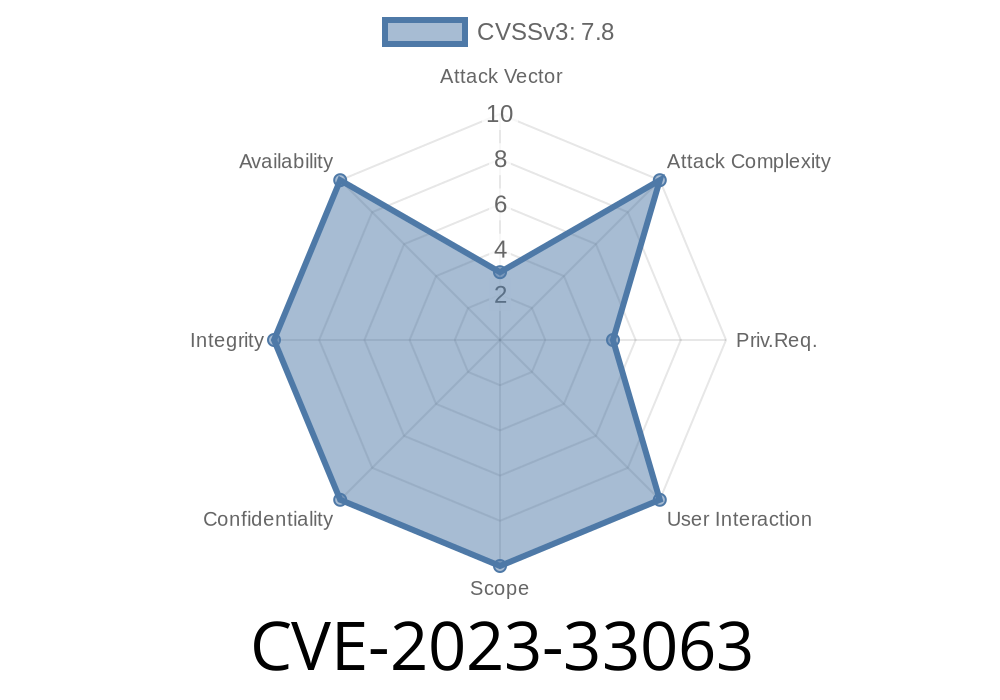A serious vulnerability—CVE-2023-33063—was discovered impacting various Qualcomm systems. This issue can lead to memory corruption in DSP (Digital Signal Processor) services when the High-Level Operating System (HLOS) like Android communicates with the DSP. In simple terms: an attacker or malicious application running in Android could manipulate the communication between Android (HLOS) and the DSP to crash the system, leak sensitive data, or in worst cases, run their code at a very privileged level.
In this exclusive breakdown, we explain what this vulnerability is, show a simple code example, reference official sources, and walk you through a proof-of-concept (PoC) attack.
The Official Description
According to Qualcomm’s Security Bulletin, the vulnerability is:
> "Memory corruption in DSP Services during a remote call from HLOS to DSP due to improper validation of user data may allow a local attacker to cause denial of service or potentially gain code execution."
Where: DSP (Digital Signal Processor) Services
- How: Improper input validation in remote HLOS (Android/Linux) to DSP call
2. How Does the Vulnerability Work?
The DSP in devices like smartphones acts as a hardware coprocessor, often handling complex tasks like audio, camera processing, or AI inference. The Android OS talks to the DSP using a set of APIs, typically via "remote procedure call" (RPC) interfaces.
If DSP Service code assumes that all data coming from HLOS is trustworthy and does not thoroughly check or sanitize it, it can crash or, more dangerously, let an attacker control pointers in DSP memory. This could allow:
3. Exploit Details & Sample Code
NOTE: This is for educational and defensive purposes only. Do not use to attack real devices!
The vulnerable interface: Typically, Qualcomm devices expose DSP services via "QMI" (Qualcomm MSM Interface) or "FastRPC" interfaces. Many DSP bugs have involved sending a malformed message to these endpoints.
Example Vulnerable Flow
// C-like DSP service pseudocode
struct Request {
uint32_t len;
char data[256];
};
void handle_request(struct Request *req) {
char buffer[256];
// Vulnerable: copies user-supplied length without checks!
memcpy(buffer, req->data, req->len); // OOPS, no size check!
}
If req->len is higher than 256, this overwrites nearby memory—classic buffer overflow.
Here's what a (simplified) PoC might look like from Android, using an app with low privileges
# Python pseudocode for local exploit (for rooted/testing devices)
import struct
from some_qualcomm_rpc_library import send_to_dsp
# Construct a malformed request
malicious_len = 1024 # much larger than buffer
payload = b'A' * malicious_len
request = struct.pack('<I', malicious_len) + payload[:256] # Hack up the request
# Send to vulnerable DSP service
response = send_to_dsp('vulnerable_service', request)
print("Response:", response)
These kinds of requests can make the DSP crash (causing device instability) or, with precision, let an attacker run code.
Affected devices include but are not limited to
- Many Qualcomm Snapdragon chipsets in Android phones, including devices from Samsung, Xiaomi, OnePlus, etc.
- Devices running unpatched firmware prior to June 2023 Security Bulletin.
5. Patching & Mitigation
- OEMs & Carriers: Update to the latest firmware/OTA as provided by your manufacturer/carrier.
Qualcomm June 2023 Bulletin:
https://www.qualcomm.com/company/product-security/bulletins/june-2023-bulletin
NIST NVD Entry:
https://nvd.nist.gov/vuln/detail/CVE-2023-33063
Qualcomm DSP Exploitation Research:
https://research.checkpoint.com/202/qualcomm-dsp-gateway-to-android-ecosystem/
7. Conclusion
CVE-2023-33063 is a textbook example of why data validation is critical—especially at the boundary between application software (Android) and specialized hardware (DSP). Even though these vulnerabilities require local access (such as a malicious app or process), they have powerful impacts—leading to device crashes or even remote control if chained with other bugs.
If you’re a developer: Always double-check your boundaries and never trust input from less-privileged software—even inside your own device.
If you’re a user: Stay updated, beware of shady apps, and keep an eye on security bulletins from your device maker.
Have questions or want to share more info? Leave a comment below or reach out for further technical details!
Timeline
Published on: 12/05/2023 03:15:12 UTC
Last modified on: 12/11/2023 18:20:10 UTC
